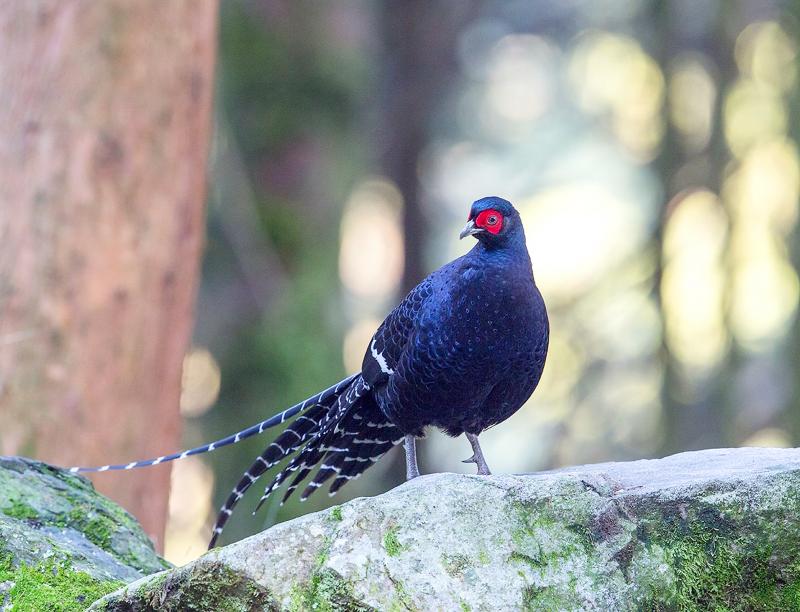The mikado pheasant, also known as “emperor’s pheasant,” is a species of pheasant endemic to Taiwan that is featured on Taiwan’s NT$1,000 bill. The mikado pheasant was once on the verge of extinction. However, thanks to the hard efforts of conservation workers, it has now returned to stable population levels. The Ministry of the Interior on Thursday shared the good news on its official Facebook page. It is a hard-won achievement that has been 30 years in the making. The ministry used the post to remind the public that if they encounter mikado pheasants while in mountainous or forest areas, they should admire the birds from a distance and refrain from disturbing them. The ministry also said that it hopes everyone will work together to protect Taiwan’s ecological diversity.
Taiwan is the only country in the world to have achieved success with a mikado pheasant breeding program. Since it was discovered that the mikado pheasant faced extinction, during 30 years of observation, the bird’s population within Yushan National Park has increased from just over 5,000 in 1986 to more than 10,000 today.
According to the Yushan National Park Administration Office, the mikado pheasant’s name was coined in 1906 when British ornithologists traveled to Yushan to collect specimens and inadvertently discovered two tail feathers of a male mikado pheasant on the headdress of a Tsou Aborigine. After being sent back to Britain for identification, the bird was announced as a new species.

Photo courtesy of Hsieh Yu-chen 照片:謝郁震提供
The mikado pheasant often inhabits high mountains at an altitude of 1,800 to 3,300m above sea level and it likes dense fog. In addition to Yushan National Park, the mikado pheasant can also be seen at Shei-Pa National Park and Taroko National Park.
(Translated by Edward Jones)
被印在千元鈔上的台灣特有種鳥類「帝雉」原已瀕臨絕種,不過在相關單位復育人員努力下,如今已復育有成。內政部週四特別在臉書粉專分享相關訊息,表示這是經過三十年的努力,提醒民眾若在山林巧遇牠們,可以遠遠欣賞,不要刻意驚擾,也期盼大家未來共同努力守護生態多樣的台灣。

Photo courtesy of China Airlines via CNA 照片:華航提供/中央社
全世界只有台灣有的帝雉復育有成。經過三十年觀察,發現瀕臨絕種的帝雉,已經從一九八六年玉山國家公園觀測到的五千多隻,提升到目前的超過一萬隻。
根據玉山國家公園管理處,帝雉命名起源於西元一九○六年,由英國人深入玉山進行蒐集標本工作時,無意間在鄒族人的頭飾上發現了兩根雄帝雉的尾羽,經送回英國鑑定後,發表為新品種。
帝雉常棲息於海拔一千八百到三千三百公尺高山上,喜歡濃霧,不只在玉山國家公園、雪霸國家公園,還有太魯閣國家公園都可以看到牠的蹤跡。
(自由時報)

For many people in Taiwan, childhood memories of rural life include pig pens standing beside family homes. Leftover rice, vegetable scraps and soup from daily meals were poured into buckets and fed to pigs. This practice of feeding pigs with household food waste was once a common way of life, both an economic choice and an expression of agricultural society’s deep respect for conserving resources. From a practical standpoint, pigs are omnivorous animals capable of efficiently digesting food scraps that humans can no longer eat. For rural households, food waste cost almost nothing, yet it could be converted into pork, a

Sea star wasting disease (SSWD) is a strange and serious illness affecting sea stars, or starfish. This disease causes sea stars to develop painful lesions, lose their arms, and eventually turn into a gooey, melted mess. Since it was first observed in 2013, millions of sea stars along the Pacific coast of North America have died from this __1__. Although viruses were once considered a possible cause, researchers now believe that environmental stressors and microorganisms are primarily __2__ for sea star wasting disease. One of the main environmental triggers appears to be warmer ocean water. When the water heats

Tango unfolds in a dimly lit room, where a haunting melody ushers two dancers into a close embrace. Here, music and movement merge into a silent yet passionate conversation, expressing longing, memory and shared purpose. What makes tango truly magical is the deep interaction and spontaneous improvisation between partners. Tango began in the late 19th century in Buenos Aires, Argentina’s bustling capital. Born in the poor working-class neighborhoods and busy port areas, this dance emerged from a melting pot of cultures. European immigrants, African slaves and local residents all contributed to its unique character. From these rich influences, tango

Continued from yesterday(延續自昨日) https://www.taipeitimes.com/News/lang The loss of sea stars significantly impacts the ocean ecosystem. Sea stars are important __6__ that help control populations of mussels and sea urchins. Among them, the sunflower star is one of the largest and fastest sea stars and is adept at preying on sea urchins. Without sea stars, sea urchins can __7__ in numbers and devastate kelp forests. These forests are essential __8__ for many marine animals and also help capture carbon from the atmosphere, which is vital in the fight against climate change. The mystery behind SSWD is still __9__, but it is clear that